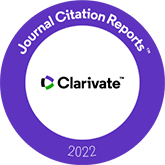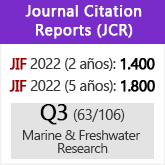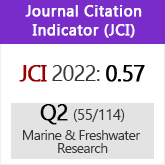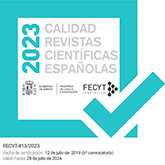Métodos físicos y químicos de marcaje del erizo de mar Paracentrotus lividus (Echinodermata: Echinoidea)
DOI:
https://doi.org/10.3989/scimar.05259.038Palabras clave:
equinodermo, calceína, PIT-tag, coded wire tag, repoblación, acuicultura, estudios ecológicosResumen
El erizo de mar Paracentrotus lividus (Lamarck, 1816) (Echinodermata: Echinoidea) representa un recurso económico relevante en Europa, pero su intensa explotación ha llevado al colapso de varias poblaciones naturales. La acuicultura de erizos de mar, asociada a las prácticas de repoblación y mejora del stock son alternativas a este problema. En estos procedimientos, una identificación individual fiable, a través de métodos de marcaje, representa una valiosa fuente de información. Sin embargo, muy pocos estudios abordan el efecto de los métodos de marcaje en P. lividus y el marcaje de invertebrados marinos aún presenta varios desafíos: disminución del crecimiento, altas tasas de mortalidad y bajas tasas de retención de las marcas. En condiciones de laboratorio, el presente estudio evaluó la eficacia de tres métodos de marcaje (passive integrated transponders - PIT-tags, coded wire tags - CWT y calceína) en P. lividus silvestre, durante 60 días, en términos de peso húmedo total, ganancia de peso (mg ind.−1 día−1), supervivencia y retención de etiquetas. El peso húmedo total final fue significativamente mayor en el grupo sin marcar (control), en comparación con los individuos marcados con PIT-tags. La tasa de supervivencia fue del 100% para los grupos PIT-tag, Calceína y Control, y del 97% para el grupo CWT. La retención de etiquetas fue significativamente diferente según el método de etiquetado: 100% en el grupo Calceína, 76,7% en el grupo PIT-tag y 38,0% en el grupo CWT.
Descargas
Citas
Acolas M.L., Roussel J.M., Lebel J.M., Baglinière J.L. 2007. Laboratory experiment on survival, growth and tag retention following PIT injection into the body cavity of juvenile brown trout (Salmo trutta). Fish. Res. 86: 280-284. https://doi.org/10.1016/j.fishres.2007.05.011
Agatsuma Y. 2020. Stock enhancement of regular sea urchins. In: Lawrence J.M. (ed), Sea Urchins: Biology and Ecology. Academic Press, San Diego, CA, pp. 299-313. https://doi.org/10.1016/B978-0-12-819570-3.00017-2
Agatsuma Y.U., Nakata A.K., Matsuyama K.E. 2000. Seasonal foraging activity of the sea urchin Strongylocentrotus nudus on coralline flats in Oshoro Bay in south-western Hokkaido, Japan. Fish. Sci. 66: 198-203. https://doi.org/10.1046/j.1444-2906.2000.00035.x
Andrew N., Agatsuma Y., Ballesteros E., et al. 2002. Status and management of world sea urchin fisheries. Oceanogr. Mar. Biol. 40: 343-425. https://doi.org/10.1201/9780203180594.ch7
Barbaglio A., Tricarico S., Ribeiro A., et al. 2012. The mechanically adaptive connective tissue of echinoderms: Its potential for bio-innovation in applied technology and ecology. Mar. Environ. Res. 76: 108-113. https://doi.org/10.1016/j.marenvres.2011.07.006 PMid:21864892
Bartley D.M., Bell J.D. 2008. Restocking, stock enhancement, and sea ranching: Arenas of progress. Rev. Fish. Sci. 16: 357-365. https://doi.org/10.1080/10641260701678058
Bell J.D., Bartley D.M., Lorenzen K., Loneragan N.R. 2006. Restocking and stock enhancement of coastal fisheries: Potential, problems and progress. Fish. Res. 80: 1-8. https://doi.org/10.1016/j.fishres.2006.03.008
Bertocci I., Dominguez R., Machado I., et al. 2014. Multiple effects of harvesting on populations of the purple sea urchin Paracentrotus lividus in north Portugal. Fish. Res. 150: 60-65. https://doi.org/10.1016/j.fishres.2013.10.010
Boada J., Sanmartí N., Selden R.L., et al. 2015. Evaluating potential artifacts of tethering techniques to estimate predation on sea urchins. J. Exp. Mar. Bio. Ecol. 471: 17-22. https://doi.org/10.1016/j.jembe.2015.05.011
Boudouresque C.F., Blanfuné A., Pergent G., et al. 2020. Impacts of Marine and Lagoon Aquaculture on Macrophytes in Mediterranean Benthic Ecosystems. Front. Mar. Sci. 7: 218. https://doi.org/10.3389/fmars.2020.00218
Brown L.R., Caldwell G.S. 2017. Tissue and spine regeneration in the temperate sea urchin Psammechinus miliaris. Invertebr. Reprod. Dev. 61: 90-96. https://doi.org/10.1080/07924259.2017.1287779
Candia Carnevali M.D. 2006. Regeneration in Echinoderms: repair, regrowth, cloning. Invertebr. Surviv. J. 3: 64-76.
Cieciel K., Pyper B.J., Eckert G.L. 2009. Tag retention and effects of tagging on movement of the giant red sea cucumber Parastichopus californicus. North Am. J. Fish. Manag. 29: 288-294. https://doi.org/10.1577/M07-194.1
Cipriano A., Burnell G., Culloty S., Long S. 2014. Evaluation of 3 tagging methods in marking sea urchin, Paracentrotus lividus, populations under both laboratory and field conditions. J. Aquac. Res. Dev. 5: 276. https://doi.org/10.4172/2155-9546.1000276
Clemente S., Hernández J.C., Brito A. 2007. An external tagging technique for the long-spined sea urchin Diadema aff. antillarum. J. Mar. Biol. Assoc. United Kingdom. 87: 777-779. https://doi.org/10.1017/S0025315407053349
Cyrus M.D., Bolton J.J., De Wet L., Macey B.M. 2013. The development of a formulated feed containing Ulva (Chlorophyta) to promote rapid growth and enhanced production of high quality roe in the sea urchin Tripneustes gratilla (Linnaeus). Aquac. Res. 45: 159-176. https://doi.org/10.1111/j.1365-2109.2012.03219.x
D'Arcy J., Kelly S., McDermott T., et al. 2020. Assessment of PIT tag retention, growth and post-tagging survival in juvenile lumpfish, Cyclopterus lumpus. Anim. Biotelemetry. 8: 1-9. https://doi.org/10.1186/s40317-019-0190-6
Delorme N.J., Sewell M.A. 2016. Effects of warm acclimation on physiology and gonad development in the sea urchin Evechinus chloroticus. Comp. Biochem. Physiol. Part A Mol. Integr. Physiol. 198: 33-40. https://doi.org/10.1016/j.cbpa.2016.03.020 PMid:27043875
Duggan R.E., Miller R.J. 2001. External and internal tags for the green sea urchin. J. Exp. Mar. Bio. Ecol. 258: 115-122. https://doi.org/10.1016/S0022-0981(01)00213-1
Dumont C., Himmelman J.H., Russell M.P. 2004. Size-specific movement of green sea urchins Strongylocentrotus droebachiensis on urchin barrens in eastern Canada. Mar. Ecol. Prog. Ser. 276: 93-101. https://doi.org/10.3354/meps276093
Dworjanyn S.A., Byrne M. 2018. Impacts of ocean acidification on sea urchin growth across the juvenile to mature adult life-stage transition is mitigated by warming. Proc. R. Soc. B Biol. Sci. 285: 20172684. https://doi.org/10.1098/rspb.2017.2684 PMid:29643209 PMCid:PMC5904309
Ebert T. 2004. Shrinking sea urchins and the problems of measurement. In: Heinzeller T., Nebelsick J. (eds), Echinoderms: München. Balkema, London, pp. 321-326. https://doi.org/10.1201/9780203970881.pt4
Ebert T.A. 1965. A technique for the individual marking of sea urchins. Ecology. 46: 193-194. https://doi.org/10.2307/1935273
Ebert T.A. 2013. Growth and survival of postsettlement sea urchins. In: Lawrence J.M. (ed), Sea Urchins: Biology and Ecology. Academic Press, San Diego, California, pp. 83-117. https://doi.org/10.1016/B978-0-12-396491-5.00007-1
Ebert T.A. 2017. A Problem in Measuring Sea Urchins. Ann. Mar. Biol. Res. 4: 1026.
Ebert T.A., Russell M.P., Gamba G., Bodnar A. 2008. Growth, survival, and longevity estimates for the rock-boring sea urchin Echinometra lucunter lucunter (Echinodermata, Echinoidea) in Bermuda. Bull. Mar. Sci. 82: 381-403.
Ellers O., Johnson A.S. 2009. Polyfluorochrome marking slows growth only during the marking month in the green sea urchin Strongylocentrotus droebachiensis. Invertebr. Biol. 128: 126-144. https://doi.org/10.1111/j.1744-7410.2008.00159.x
Estefanell J., Socorro J., Afonso J.M., Roo J., Fernandez-Palacios H., Izquierdo M.S. 2011. Evaluation of two anaesthetic agents and the passive integrated transponder tagging system in Octopus vulgaris (Cuvier 1797). Aquac. Res. 42: 399-406. https://doi.org/10.1111/j.1365-2109.2010.02634.x
FAO. 2020. The State of World Fisheries and Aquaculture 2020. Sustainability in action. FAO, Rome, Italy, pp. 244.
Fox E., Meyer E., Panasiak N., Taylor A.R. 2018. Calcein staining as a tool to investigate coccolithophore calcification. Front. Mar. Sci. 5: 326. https://doi.org/10.3389/fmars.2018.00326
Gheorghiu C., Hanna J., Smith J.W., et al. 2010. Encapsulation and migration of PIT tags implanted in brown trout (Salmo trutta L.). Aquaculture 298: 350-353. https://doi.org/10.1016/j.aquaculture.2009.10.004
Gianasi B.L., Verkaik K., Hamel J.F., Mercier A. 2015. Novel Use of PIT Tags in Sea Cucumbers: Promising Results with the Commercial Species Cucumaria frondosa. PLoS One. 10: e0127884. https://doi.org/10.1371/journal.pone.0127884 PMid:26011165 PMCid:PMC4444348
Gibbons J.W., Andrews K.M. 2004. PIT tagging: Simple technology at its best. Bioscience 54: 447-454. https://doi.org/10.1641/0006-3568(2004)054[0447:PTSTAI]2.0.CO;2
Gorzelak P., Dery A., Dubois P., Stolarski J. 2017. Sea urchin growth dynamics at microstructural length scale revealed by Mn-labeling and cathodoluminescence imaging. Front. Zool. 14: 1-17. https://doi.org/10.1186/s12983-017-0227-8 PMid:28855950 PMCid:PMC5574115
Grosso L., Rakaj A., Fianchini A., et al. 2021. Integrated Multi-Trophic Aquaculture (IMTA) system combining the sea urchin Paracentrotus lividus, as primary species, and the sea cucumber Holothuria tubulosa as extractive species. Aquaculture 534: 736268. https://doi.org/10.1016/j.aquaculture.2020.736268
Guy C.S., Schultz R.D., Clouse C.P. 1996. Coded Wire Tag Loss from Paddlefish: A Function of Study Location. North Am. J. Fish. Manag. 16: 931-934. https://doi.org/10.1577/1548-8675(1996)016<0931:CWTLFP>2.3.CO;2
Haag N., Russell M.P., Hernandez J.C., Dollahon N. 2013. Assessing fluorochrome-staining efficacy in the green sea urchin, Strongylocentrotus droebachiensis (Muller, 1776). Cah. Biol. Mar. 54: 625-631.
Hagen N.T. 1996. Tagging sea urchins: a new technique for individual identification. Aquaculture 139: 271-284. https://doi.org/10.1016/0044-8486(95)01156-0
Harianto J., Nguyen H.D., Holmes S.P., Byrne M. 2018. The effect of warming on mortality, metabolic rate, heat-shock protein response and gonad growth in thermally acclimated sea urchins (Heliocidaris erythrogramma). Mar. Biol. 165: 96. https://doi.org/10.1007/s00227-018-3353-8
Jacinto D., Penteado N., Pereira D., Sousa A., Cruz T. 2015. Growth rate variation of the stalked barnacle Pollicipes pollicipes (Crustacea: Cirripedia) using calcein as a chemical marker. Sci. Mar. 79: 117-123. https://doi.org/10.3989/scimar.04135.08B
Johnson A.S., Salyers J.M., Alcorn N.J., et al. 2013. Externally visible fluorochrome marks and allometries of growing sea urchins. Invertebr. Biol. 132: 251-269. https://doi.org/10.1111/ivb.12024
Kalvass P.E., Hendrix J.M., Law P.M. 1998. Experimental analysis of 3 internal marking methods for red sea urchins. Calif. Fish Game. 84: 88-99.
de la Uz S., Carrasco J.F., Rodríguez C., López J. 2018. Evaluation of tagging and substrate refuges in release of juvenile sea urchins. Reg. Stud. Mar. Sci. 23: 8-11. https://doi.org/10.1016/j.rsma.2018.02.008
Larsen M.H., Thorn A.N., Skov C., Aarestrup K. 2013. Effects of passive integrated transponder tags on survival and growth of juvenile Atlantic salmon Salmo salar. Anim. Biotelemetry 1: 1-7. https://doi.org/10.1186/2050-3385-1-19
Lauzon-Guay J.S., Scheibling R.E. 2008. Evaluation of passive integrated transponder (PIT) tags in studies of sea urchins: caution advised. Aquat. Biol. 2: 105-112. https://doi.org/10.3354/ab00040
Li H., Lei Y., Li T., Jian Z. 2020. Effects of calcein incorporation on benthic foraminiferal community under various concentrations and incubation durations. Mar. Micropaleontol. 157: 101874. https://doi.org/10.1016/j.marmicro.2020.101874
Lourenço S., Cunha B., Raposo A., et al. 2021. Somatic growth and gonadal development of Paracentrotus lividus (Lamarck, 1816) fed with diets of different ingredient sources. Aquaculture 539: 736589. https://doi.org/10.1016/j.aquaculture.2021.736589
Martin R.A. 2011. Evaluating a novel technique for individual identification of anuran tadpoles using coded wire tags. Herpetol. Conserv. Biol. 6: 155-160.
Mattison J.E., Trent J.D., Shanks A.L., Akin T.B., Pearse J.S. 1976. Movement and feeding activity of red sea urchins (Strongylocentrotus franciscanus) adjacent to a kelp forest. Mar. Biol. 1977 391. 39: 25-30. https://doi.org/10.1007/BF00395589
McClanahan T.R., Muthiga N.A. 1989. Patterns of predation on a sea urchin, Echinometra mathaei (de Blainville), on Kenyan coral reefs. J. Exp. Mar. Bio. Ecol. 126: 77-94. https://doi.org/10.1016/0022-0981(89)90125-1
Monaghan J.P. 1993. Notes: Comparison of Calcein and Tetracycline as Chemical Markers in Summer Flounder. Trans. Am. Fish. Soc. 122: 298-301. https://doi.org/10.1577/1548-8659(1993)122<0298:NCOCAT>2.3.CO;2
Moran A.L. 2000. Calcein as a marker in experimental studies newly-hatched gastropods. Mar. Biol. 137: 893-898. https://doi.org/10.1007/s002270000390
Mos B., Byrne M., Dworjanyn S.A. 2016. Biogenic acidification reduces sea urchin gonad growth and increases susceptibility of aquaculture to ocean acidification. Mar. Environ. Res. 113: 39-48. https://doi.org/10.1016/j.marenvres.2015.11.001 PMid:26595392
Navarro A., Oliva V., Zamorano M.J., et al. 2006. Evaluation of PIT system as a method to tag fingerlings of gilthead seabream (Sparus auratus L.): Effects on growth, mortality and tag loss. Aquaculture 257: 309-315. https://doi.org/10.1016/j.aquaculture.2006.02.072
Olsen T.B., Christensen F.E.G., Lundgreen K., et al. 2015. Coelomic transport and clearance of durable foreign bodies by starfish (Asterias rubens). Biol. Bull. 228: 156-162. https://doi.org/10.1086/BBLv228n2p156 PMid:25920718
Omeyer L.C.M., Casale P., Fuller W.J., et al. 2019. The importance of passive integrated transponder (PIT) tags for measuring life-history traits of sea turtles. Biol. Conserv. 240: 108248. https://doi.org/10.1016/j.biocon.2019.108248
Palleiro-Nayar J.S., Sosa-Nishizaki O., Montaño-Moctezuma G. 2009. Estimación de la tasa de crecimiento corporal del erizo rojo Strongylocentrotus franciscanus en cautiverio y en el Arrecife Sacramento en la Bahía El Rosario, Baja California, México. Cienc. Pesq. 17: 21-28.
Pennock C.A., Frenette B.D., Waters M.J., Gido K.B. 2016. Survival of and tag retention in Southern Redbelly dace injected with two sizes of PIT tags. North Am. J. Fish. Manag. 36: 1386-1394. https://doi.org/10.1080/02755947.2016.1227403
Purcell S.W., Blockmans B.F. 2009. Effective fluorochrome marking of juvenile sea cucumbers for sea ranching and restocking. Aquaculture 296: 263-270. https://doi.org/10.1016/j.aquaculture.2009.08.027
Purcell S.W., Blockmans B.F., Nash W.J. 2006. Efficacy of chemical markers and physical tags for large-scale release of an exploited holothurian. J. Exp. Mar. Bio. Ecol. 334: 283-293. https://doi.org/10.1016/j.jembe.2006.02.007
Rodríguez-Barreras R., Sabat A.M. 2015. Evaluation of three tagging methods in the sea urchin Diadema antillarum. J. Mar. Biol. Assoc. United Kingdom. 95: 1255-1260. https://doi.org/10.1017/S0025315415000302
Rodríguez-Barreras R., Sonnenholzner J. 2014. Effect of Implanted PIT-Tags on Growth, Survival, and Tag Retention in the Sea Urchin Tripneustes ventricosus. Caribb. J. Sci. 48: 132-137. https://doi.org/10.18475/cjos.v48i3.a02
Rodríguez-Barreras R., Wangensteen O.S. 2016. Assessing the reliability of two tagging techniques in the echinoid Echinometra lucunter. Reg. Stud. Mar. Sci. 5: 51-54. https://doi.org/10.1016/j.rsma.2016.01.006
Rodríguez A., Hernández J.C., Clemente S. 2016. Efficiency of calcein tagging on juveniles of the sea urchins Diadema africanum and Paracentrotus lividus. Mar. Ecol. 37: 463-469. https://doi.org/10.1111/maec.12287
Rodríguez-Barreras R., López-Morell J., Sabat A.M. 2017. Effectiveness of two tagging devices in the sea cucumber Holothuria (Halodeima) grisea. Mar. Freshw. Res. 68: 563-567. https://doi.org/10.1071/MF15473
Rogers-Bennett L., Rogers D.W., Bennett W.A., Ebert T.A. 2003. Modeling red sea urchin (Strongylocentrotus franciscanus) growth using six growth functions. Fish. Bull. 101: 614-626.
Russell M.P., Urbaniak L.M. 2004. Does calcein affect estimates of growth rates in sea urchins? In: Heinzeller T., Nebelsick J.H. (eds), Echinoderms: München - Proceedings of the 11th International Echinoderm Conference, 6-10 October 2003, Munich, Germany. Taylor & Francis Group, London, pp. 53-57. https://doi.org/10.1201/9780203970881.ch10
Sandford M., Castillo G., Hung T.C. 2020. A review of fish identification methods applied on small fish. Rev. Aquac. 12: 542-554. https://doi.org/10.1111/raq.12339
Sano M., Seki T., Omori M., Taniguchi K. 2001. A tagging method for the sea urchin Strongylocentrotus nudus (A. Agassiz) with Coded Wire Tag. Nippon Suisan Gakkaishi. 67: 23-29. https://doi.org/10.2331/suisan.67.23
Santos P.M., Albano P., Raposo A., et al. 2020a. The effect of temperature on somatic and gonadal development of the sea urchin Paracentrotus lividus (Lamarck, 1816). Aquaculture 528: 735487. https://doi.org/10.1016/j.aquaculture.2020.735487
Santos P.M., Ferreira S.M.F., Albano P., et al. 2020b. Can artificial diets be a feasible alternative for the gonadal growth and maturation of the sea urchin Paracentrotus lividus (Lamarck, 1816)? J. World Aquac. Soc. 51: 463-487. https://doi.org/10.1111/jwas.12656
Sato T., Yoseda K., Abe O., et al. 2013. Growth of the coconut crab Birgus latro estimated from mark-recapture using passive integrated transponder (PIT) tags. Aquat. Biol. 19: 143-152. https://doi.org/10.3354/ab00517
Searcy-Bernal R., Montaño-Moctezuma G., Anguiano-Beltrán C., et al. 2016. Preliminary Studies on the Use of Pit Tags to Evaluate Abalone Restocking. J. Shellfish Res. 35: 677-683. https://doi.org/10.2983/035.035.0314
Shao N., Chen J., Hu J., et al. 2017. Visual detection of multiple genetically modified organisms in a capillary array. Lab Chip. 17: 521-529. https://doi.org/10.1039/C6LC01330A PMid:28092385
Shpigel M., McBride S.C., Marciano S., Lupatsch I. 2004. The effect of photoperiod and temperature on the reproduction of European sea urchin Paracentrotus lividus. Aquaculture 232: 343-355. https://doi.org/10.1016/S0044-8486(03)00539-8
Sonnenholzner J.I., Montaño-Moctezuma G., Searcy-Bernal R. 2011. Effect of three tagging methods on the growth and survival of the purple sea urchin Strongylocentrotus purpuratus. Panam. J. Aquat. Sci. 5: 414-420.
Stefánsson G., Kristinsson H., Ziemer N., et al. 2017. Markets for sea urchins: a review of global supply and markets. Intern. Matis Rep. Skýrsla Matís.
Sun J., Chiang F.S. 2015. Use and Exploitation of Sea Urchins. In: Brown N.P., Eddy S.D. (eds), Echinoderm Aquaculture. John Wiley & Sons, Inc., Hoboken, New Jersey, pp. 25-45. https://doi.org/10.1002/9781119005810.ch2
Tourón N., Paredes E., Costas D. 2022. Comparison of the Effectiveness of Different Tags in the Sea Urchin Paracentrotus lividus (Lamarck, 1816). In: Hufnagel L. (ed), Biodiversity of Ecosystems. IntechOpen, London, pp. 1-11. https://doi.org/10.5772/intechopen.102594
Wilson C.D., Arnott G., Reid N., Roberts D. 2011. The pitfall with PIT tags: marking freshwater bivalves for translocation induces short-term behavioural costs. Anim. Behav. 81: 341-346. https://doi.org/10.1016/j.anbehav.2010.10.003
Woods C.M.C., James P.J. 2005. Evaluation of passive integrated transponder tags for individually identifying the sea urchin Evechinus chloroticus (Valenciennes). Aquac. Res. 36: 730-732. https://doi.org/10.1111/j.1365-2109.2005.01277.x
Zakęś Z., Rożyński M., Demska-Zakęś K. 2019. Effect of PIT tagging on hematology and plasma composition of juvenile pikeperch (Sander lucioperca (L.). Aquac. Int. 27: 971-981. https://doi.org/10.1007/s10499-019-00357-7
Publicado
Cómo citar
Número
Sección
Licencia
Derechos de autor 2022 Consejo Superior de Investigaciones Científicas (CSIC)

Esta obra está bajo una licencia internacional Creative Commons Atribución 4.0.
© CSIC. Los originales publicados en las ediciones impresa y electrónica de esta Revista son propiedad del Consejo Superior de Investigaciones Científicas, siendo necesario citar la procedencia en cualquier reproducción parcial o total.Salvo indicación contraria, todos los contenidos de la edición electrónica se distribuyen bajo una licencia de uso y distribución “Creative Commons Reconocimiento 4.0 Internacional ” (CC BY 4.0). Puede consultar desde aquí la versión informativa y el texto legal de la licencia. Esta circunstancia ha de hacerse constar expresamente de esta forma cuando sea necesario.
No se autoriza el depósito en repositorios, páginas web personales o similares de cualquier otra versión distinta a la publicada por el editor.
Datos de los fondos
Fundação para a Ciência e a Tecnologia
Números de la subvención UIDB/04292/2020;MAR-02.01.01-FEAMP-0004;MAR-01.03.02-FEAMP-0012
















